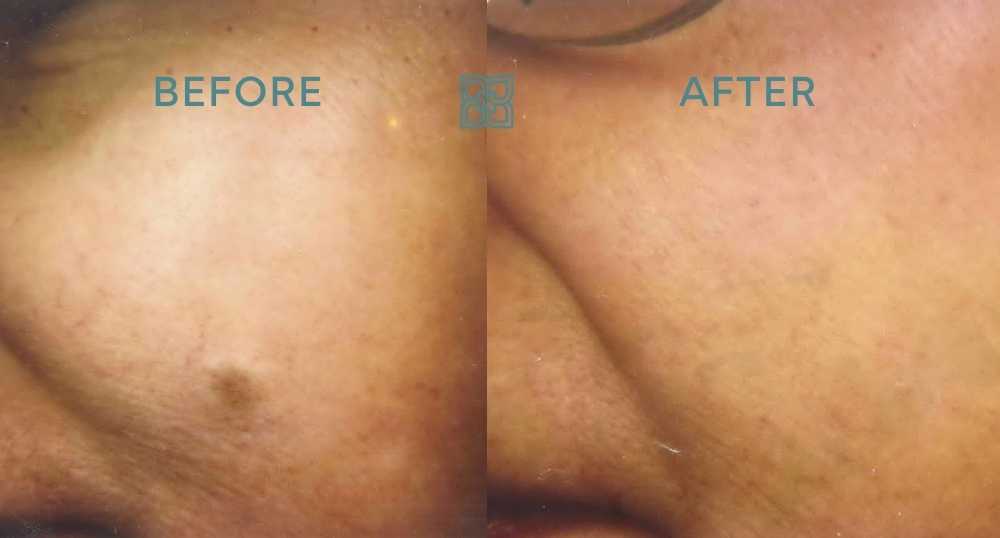Moles


Moles are harmless skin growths that can be flat or protruding. They vary in colour from pink and skin tones, to dark brown or black pigmented lesions. A skin tag and a mole are different types of growths but can occasionally look very similar. Everyone has them; some of us have a lot, and others have only a few. The number depends on our genes. They sometimes appear in “crops”, especially during the early teens.
Moles can begin to grow in infancy, and new ones can develop at any age. They can appear anywhere from the face and scalp to the toes. Once one appears, it usually stays for life without becoming a medical problem. A mole that grows or changes in childhood is almost always harmless. On the other hand, if a mole in an adult markedly changes in colour, size, or shape it should be checked by a physician to ensure that it is not cancerous. If a mole is changing, it is important to assess the ABCDEs of moles.
Moles can sometimes be dangerous and it is important to assess moles to determine if they might be dysplastic moles or even malignant melanomas, which is a type of skin cancer. It is very important to identify cancerous melanomas early as if left too long, they can spread to other parts of the body, such as lungs or liver. Dermatologists may examine suspicious moles with a dermatoscope, which is a device that allows the dermatologist to see the mole more closely and to see slightly under the surface of the skin.
What if My Mole is Itchy?
An itchy mole could potentially be the sign of something concerning but more often than not, it simply means the mole is slightly irritated and once it settles down, the itch will go away.
Are Raised Moles Dangerous?
Raised moles can be dangerous but are not necessarily so. In fact, many patients are worried about heir raised moles and point these out to our dermatologist, Dr. Nakatsui. However, more often than not, these raised moles are completely harmless, particularly if they are soft and skin-coloured.
D.L.
Thank you for your kindness and patience when you worked on my daughter. The moles on her face have always caused her to be teased and embarrassed. She told me that she thinks you must be the greatest and the nicest doctor she has ever met.

How Can Moles be Removed?
Moles can be removed in a few different ways, ranging from elliptical excision to laser mole removal using a combination of carbon dioxide laser resurfacing and picosecond pigment laser treatments or CellFX.The advantages of elliptical excision is that you can be assured of complete removal of all mole cells and any hair that might be growing from it; the disadvantage is that you will be left with a linear scar. Most patients prefer laser removal. Discuss this with our skin specialist, dermatologist Dr. Thomas Nakatsui.
Before and After Laser Mole Removal Photos

**Actual patient. Individual results may vary.
Treatments for Moles
Laser Mole Removal Laser Pigment Removal Ablative Laser ResurfacingCellFX
Frequently Asked Questions
How Are Moles Treated?
– A mole that bleeds, is an unusual shape, grows rapidly, or changes markedly in colour may be malignant and should be removed and analyzed by a pathologist.
– An annoyance mole that is irritated by your clothing, hair utensils, or razors are often removed to prevent ongoing irritation.
– A mole that is unattractive to the patient is removed for cosmetic reasons.
Before removing a mole for cosmetic reasons, it is best to have the mole evaluated by your dermatologist to ensure that it is benign.
How Are Moles Removed?
There are two ways to remove moles:
- A sample of the mole is taken with a scalpel, and then the area is resurfaced with a carbon dioxide laser to smooth and blend the treatment site with the surrounding tissue (and possibly treated with a picosecond pigment removal laser to remove residual pigment), OR
- Some moles can be treated with a newer treatment called CellFX, which uses nano-pulse technology (billionths of a second pulses of electricity), OR
- The mole is excised and sutured. This technique is usually reserved for melanomas (mole cancers) as it will leave a more obvious scar than the first method.
All mole samples are sent to the laboratory where a pathologist examines it under a microscope to ensure that it is normal. If the mole is suspicious for malignancy, the analysis of the mole by the pathologist is covered completely by Alberta Health. If the mole is removed for cosmetic reasons and a laser is used, the cost of the removal and analysis of the mole by a pathologist is the responsibility of the patient.
Treatments may need to be repeated as the deeper layers of the mole and islands of pigment may push to the surface with time. Moles sometimes grow annoyingly coarse hairs, which may be safely removed by shaving or tweezing. Permanent removal of the hair, which have roots deep within the skin, requires laser, electrolysis, or complete surgical excision of the mole. The latter will leave a scar.
How Do I Check To See If A Mole Is Abnormal?
Follow the ABCD’s of moles to be sure you have noted all the possible types of changes in a mole which may indicate a problem.
Asymmetry:
Asymmetry means that a mole does not look the same on two sides and is easily determined by drawing an imaginary line through the mole. If the mole looks similar on both sides of the line, then it is symmetric and considered to have normal symmetry. If it is not the same then it is asymmetrical and may be of concern.
Border:
Border refers to the outline of a mole. Most benign moles have smooth borders. If a mole has always had a notched or irregular edge, this may not be as worrisome as when the mole used to have smooth borders and now is notched and irregular.
Colour:
Colour refers to the number of colours within the mole. Most normal moles have one or two shades of colour within them. Abnormal moles develop a mottled appearance. The more colours, the more cause for concern.
Diameter:
Diameter refers to the size of the mole. Some would say that moles greater than 6 mm in diameter are of more concern, but there are many benign moles larger than 6 mm. More important than the absolute size or width of the mole is an unexpected change in the diameter of a mole.
If in doubt, ask your dermatologist.
What is a Halo Mole?
A halo mole is also known as a halo nevus. A halo mole is a type of skin lesion where a central mole is surrounded by a zone of depigmentation or hypopigmentation. These moles are typically benign, although they should be evaluated by a dermatologist as they can sometimes be cancerous.
What are the ABCDEFs of longitudinal melanonychia?
Longitudinal melanonychia refers to the development of a dark streak in one or more nails. There are many possible causes for this, including benign moles and melanoma, hematoma (blood bruise), or pigment from fungus or bacteria. The ABCDEF rule describes some of the factors that might point towards a melanoma.
The A refers to age (peaks in 5th to 7th decade of life), African Americans, Asians, and Native Americans, the B refers to uneven borders, brown to black coloration, and breadth (width) greater than 3 mm. The C refers to change and the D refers to the digit (thumb>big toe>index finger, single digit>multiple digits). The E refers to extension of pigment onto the proximal or lateral nail fold, and the F refers to family history of funny moles or melanoma.
Is Indoor Tanning Bad for My Skin?
Indoor tanning continues to be popular despite the effort of dermatologists to stop indoor tanning in businesses and homes. Several studies indicate that tanning is associated with an increased risk of melanoma and non-melanoma skin cancers.
Despite claims from the tanning industry that the risk of skin cancer associated with indoor tanning is misleading, there are enough studies to support the damaging effects of indoor tanning–in 2009, the International Agency for Research on Cancer classified UV-emitting tanning devices as carcinogenic.
Do you have another question that wasn’t addressed here? Please feel free to contact us with any questions or concerns you may have!
